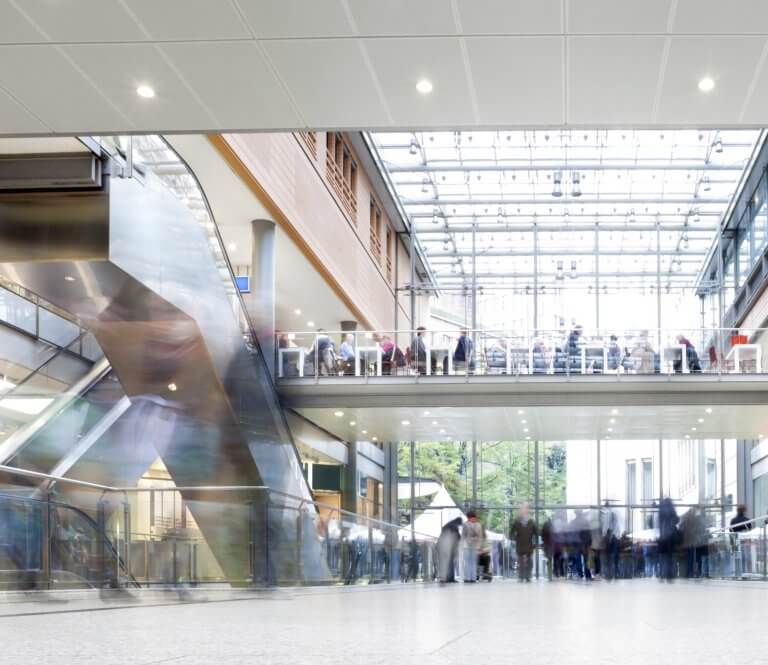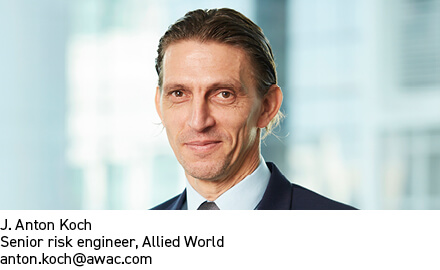By J. Anton Koch, senior risk engineer, Allied World
A combination of key measures is critical to help protect buildings from fires.
This is especially true in Asia where there are multiple high-rise shopping and residential buildings where a fire could cause havoc to hundreds and thousands of people and result in large claims.
Koch explains how to optimise the effectiveness of combining sprinkler systems with rooflights and/or heat and smoke vents to prevent fires from spiralling out of control.
Automatic sprinklers
When designing and constructing a large assembly building such as a shopping mall, the argument for having an automatic sprinkler system in place is crystal clear.
While each country in Asia has its own regulations, with more developed economies ahead of the curve, statistics show conclusively that fire sprinklers are effective in controlling or preventing the impact of fires.
The importance of effective sprinkler control could mean the difference between a business surviving or experiencing a very high loss. Having no effective fire control could mean a loss 10 or even 100 times larger, which most businesses cannot overcome.
However, by their very nature, large assembly buildings such as shopping malls, residential buildings and storage warehouses, present a number of fire safety challenges.
Life safety has been – and will always be – the number one priority for any fire prevention strategy, but ensuring that a business is well protected from all risks and eventualities will also result in reducing the potential damage to the building as well as its assets.

Effective fire control by sprinklers, if combined with rooflights and heat and smoke vents which are designed to direct the smoke out of the building quickly, may be adversely affected. While rooflights are usually installed for bringing daylight into a building, they also have a mechanism in place to open in the case of a fire.
However, if a fire does start in a large building, it’s vital to delay the activation of the heat and smoke vents and the roof light openings until the sprinklers have been activated.
The timing of this is essential in order to both adequately prevent any loss of life, but also to avoid a large asset loss. Here is the reason why: imagine a fireplace in your home, which has the elements needed to create a hot, lasting fire – heat, fuel and oxygen.
The oxygen comes from a vent in the chimney. Like fireplaces, opening rooflights or activating the heat and smoke vents too quickly in a warehouse or a shopping mall may speed up fire growth significantly and result in a spectacular Hollywood movie-style fire.
The importance of effective sprinkler control could mean the difference between a business surviving or experiencing a very high loss. Having no effective fire control could mean a loss 10 or even 100 times larger, which most businesses cannot overcome.
Helping Asia’s risk managers find the right balance
It’s possible for risk managers to find the right balance when combining rooflights and heat and smoke vents with fire sprinklers that will keep life safety as the number one priority, while at the same time putting processes in place to try to reduce the losses involved in a fire event.
Here are some of the top items to consider when looking to reduce damage to a building and its contents without compromising sprinkler effectiveness.
When you have sprinklers in combination with heat and smoke vents, always ensure: The vents are closed under normal operating conditions (they only open in case of fire emergency), and make sure metal or temperature-resistant material are used (aiming for at least 200 degrees celsius or higher) to ensure the material doesn’t melt.
In the unfortunate event of a fire, have a plan to do one of the following:
Option 1: Only allow manual opening of the vents (by the fire brigade).
Option 2: Ensure automatic vents open only after sprinklers activate – a rule of thumb could be to always use fusible links for vents opening that have at least 30 degrees celsius higher ratings than the ratings of the sprinkler glass bulbs (fusible links).
When you have sprinklers in combination with plastic rooflights, always ensure: Plastic rooflights remain in place long enough for sprinklers to activate – for conventional situations, the recommended timeframe would be five minutes.
And ensure the melting point of the plastic material (mostly applied are polycarbonate types) is at least 60 degrees celsius higher than the rating of the fire sprinkler bulb (fusible link).
To consider:
- Additional design criteria might be required by engineers for high bay and automated warehouses and for occupancies with extreme or special fire loading (for instance flammable liquids, oils, fats, aerosols, paints, high alcohol content goods).
- For conventional fire sprinkler design, use plastics with a melting point of more than 200 degrees celsius.
- Early Suppression Fast Response (ESFR) sprinklers and also Control Mode Specific Application (CMSA) sprinkler systems – which have sprinklers that activate much faster and are commonly found in large storage facilities: use plastics with a melting point of more than 100 degrees Celsius.
Problem solving
The technical nuances of balancing fire prevention strategies with asset protection and life safety can seem overwhelming, but any problems can always be solved with good risk management. Risk management is fundamental to fire safety.
At Allied World, we understand that preventing the loss of life will always come first. However, we are also committed to ensure minimum impact on assets. Therefore, we look at the challenges and solutions when faced with this dilemma to find the best options to minimise the risk.
By putting risk perspectives at the heart of discussions when mapping, engineering and designing major infrastructure projects, businesses across Asia can ensure that both people inside their premises as well as the buildings/installations themselves, are protected from every conceivable fire scenario.

J. Anton Koch is a senior risk engineer with Allied World and is currently based in Singapore. Previously, Anton worked with two large global insurance carriers where he established their semiconductors specialty business groups. Anton has over 25 years of experience within the insurance industry, embedding risk management systems for Fortune 500 clientele. His silicon platform client list includes telecommunications manufacturers, LCD screen manufacturers and other leading electronics firms. Anton has lived and worked in Europe, Asia and the US.
At Allied World, we understand that preventing the loss of life will always come first. However, we are also committed to ensure minimum impact on assets. Therefore, we look at the challenges and solutions when faced with this dilemma to find the best options to minimise the risk. By putting risk perspectives at the heart of discussions when mapping, engineering and designing major infrastructure projects, businesses can ensure that both people inside their premises as the buildings/installations themselves, are protected from every conceivable fire scenario.
For more information about Allied World’s insurance and reinsurance solutions, please visit www.alliedworldinsurance.com
This information is provided as a risk management resource and should not be construed as legal, technical or clinical advice. Consult your professional advisors or legal counsel for guidance on issues specific to you. This material may not be reproduced or distributed without the express, written permission of Allied World Assurance Company Holdings, Ltd (“Allied World”), a Fairfax company. Risk management services are provided by or arranged through the Australia, Hong Kong or Singapore branches of Allied World Assurance Company, Ltd, a member company of Allied World incorporated in Bermuda with limited liability. © 2020 Allied World Assurance Company Holdings, Ltd. All rights reserved.
-
Allianz General | Allianz General combines innovative protection solutions while powering social good to lead Malaysian market
The carrier proactively addresses emerging risks and evolving customer protection needs while giving back to the community.
-
Sedgwick | Asia’s Energy Transformation – Balancing Growth, Risk and Renewables
Energy market presents unique risks, especially in a region which includes China and Japan as well as developing nations like Vietnam and the Philippines.
-
Beazley | Turbulent Waters: the maritime energy transition challenge
Businesses are facing a complex transition to non-carbon energy sources amid a push to achieve net-zero emissions for the marine sector by 2050.
-
Aon | Navigating shifts in the global and Asia insurance markets
Neelay Patel, Aon head of growth for Asia, says the market in Asia is at an ‘interesting stage of the cycle’.
